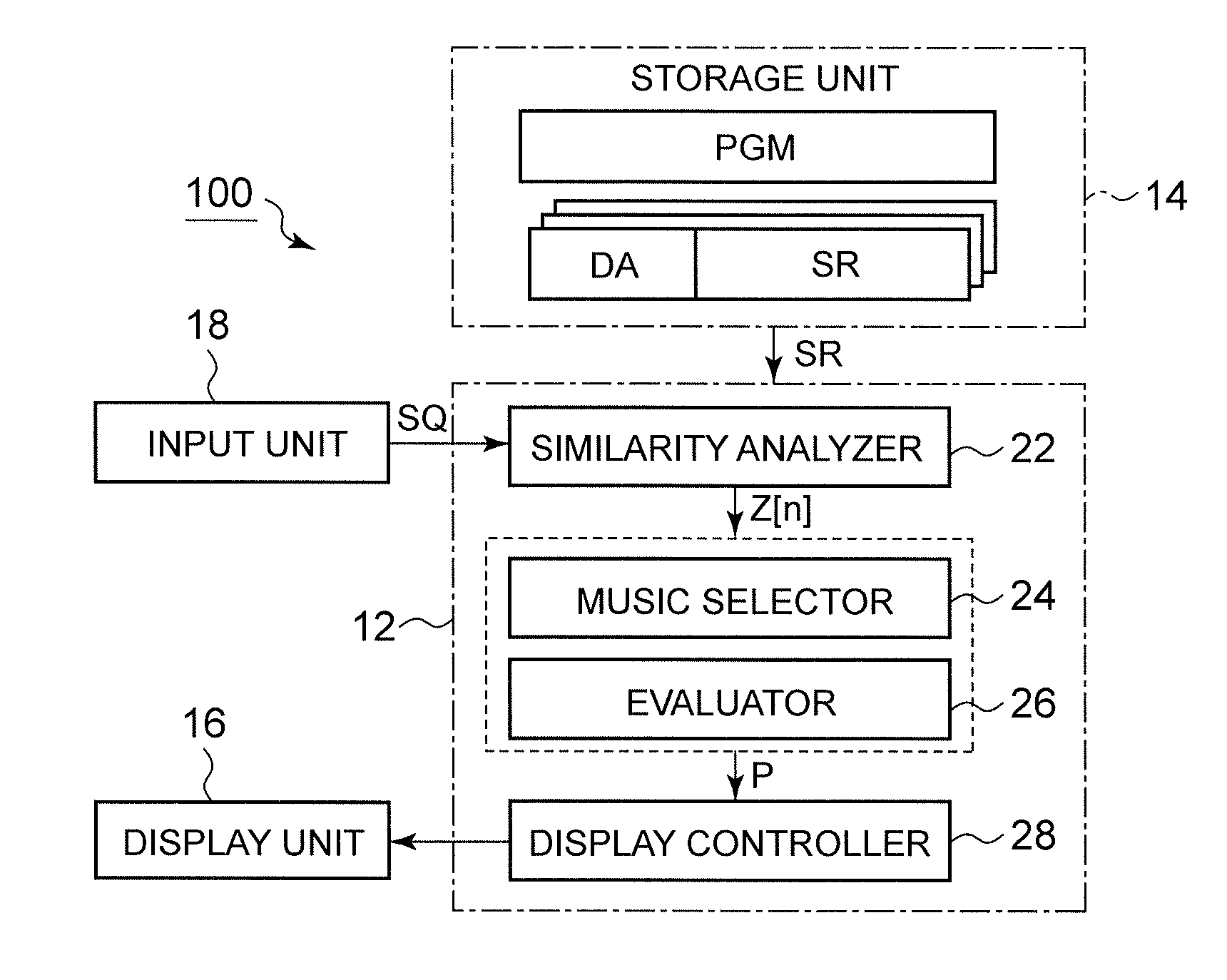Note Sequence Analysis Apparatus
a note sequence and analysis apparatus technology, applied in the field of music note sequence analysis, can solve the problems of cumbersome process and inconvenient for the user to designate a piece of musi
- Summary
- Abstract
- Description
- Claims
- Application Information
AI Technical Summary
Benefits of technology
Problems solved by technology
Method used
Image
Examples
first embodiment
[0056]FIG. 1 is a block diagram of a note sequence analysis apparatus 100 according to a first embodiment of the present invention. The note sequence analysis apparatus 100 according to the first embodiment of the invention is a signal processing apparatus that evaluates a musical correlation between a sequence of a plurality of notes designated by a user (referred to as “designated note sequence” hereinafter) and a sequence of a plurality of notes constituting a previously prepared reference piece of music (referred to as “reference note sequence” hereinafter), and is used as a performance evaluation apparatus for evaluating the performance of a piece of music by the user. As shown in FIG. 1, the note sequence analysis apparatus 100 is implemented as a computer system including a processing unit 12, a storage unit 14, a display unit 16, and an input unit 18.
[0057]The storage unit 14 stores a program PGM executed by the processing unit 12 and information used by the processing unit ...
second embodiment
[0098]A second embodiment of the present invention will now be described. In each embodiment illustrated below, elements whose operations or functions are similar to those of the first embodiment will be denoted by the same reference numerals as used in the above description and a detailed description thereof will be omitted as appropriate.
[0099]Note sequences of polyphonic music generated when a plurality of notes constituting a chord and a plurality of notes corresponding to different playing parts are sounded simultaneously may be specified as the reference note sequence SR and the designated note sequence SQ. The order of designating notes constituting a chord inputted by the user to the designated note sequence SQ can be varied according to manipulation (a fine difference between timings of inputting notes) of the user through the input unit 18, because timings of inputting a plurality of note sequences are different even if the user attempts to simultaneously designate the plu...
third embodiment
[0105]FIG. 17 illustrates the substitution cost γ used for the first analyzer 42 of the third embodiment to calculate the distance c[m1, m2] of the distance matrix C (Equation (2)). The first analyzer 42 of the second embodiment sets the tolerance period α[m1] in the designated note sequence SQ. The first analyzer 42 of the third embodiment sets a tolerance period α[m2] including the note ν[m2] of the reference note sequence SR within the reference note sequence SR, as shown in FIG. 17. FIG. 17 illustrates a case in which a tolerance period α[m2] corresponding to three notes including the note ν[m2], immediately previous note ν[m2-1], and the next note ν[m2+1] is set.
[0106]The first analyzer 42 sets the substitution cost γ, which is applied to calculation of the distance c[m1, m2] corresponding to the note ν[m1] in the designated note sequence SQ and the note ν[m2] in the reference note sequence SR, to 0 (first value) when the note ν[m1] in the designated note sequence SQ correspond...
PUM
 Login to View More
Login to View More Abstract
Description
Claims
Application Information
 Login to View More
Login to View More - R&D
- Intellectual Property
- Life Sciences
- Materials
- Tech Scout
- Unparalleled Data Quality
- Higher Quality Content
- 60% Fewer Hallucinations
Browse by: Latest US Patents, China's latest patents, Technical Efficacy Thesaurus, Application Domain, Technology Topic, Popular Technical Reports.
© 2025 PatSnap. All rights reserved.Legal|Privacy policy|Modern Slavery Act Transparency Statement|Sitemap|About US| Contact US: help@patsnap.com



